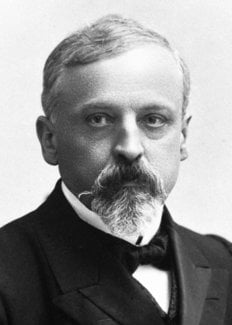Henryk Sienkiewicz
Biographical

Henryk Sienkiewicz (1846-1916), the most outstanding and prolific Polish writer of the second half of the nineteenth century, was born in Wola Okrzejska, in the Russian part of Poland. His father’s family was actively engaged in the revolutionary struggles for Polish independence, which accounts for the strong patriotic element in Sienkiewicz’ work. Historical scholarship on the other hand ran in his mother’s family.
Sienkiewicz studied in Warsaw, but without any visible results. His talent as a writer was soon discovered. His early works are satirical sketches, betraying a strong social conscience. He made a trip to America in 1876 and travelled as far as California. His impressions were published in Polish newspapers and received very favourably. His travels provided him with material for several works, among them the brilliant short story Latarnik (1882) [The Lighthouse Keeper].
After his return to Poland, Sienkiewicz devoted himself to historical studies, the result of which was his great trilogy about Poland in the midseventeenth century. Ogniem i mieczem [With Fire and Sword], Potop [The Deluge] and Pan Wolodyjowski [Pan Michael] were published in 1884, 1886, and 1888 respectively. The historical novels were followed by works on contemporary subjects: Bez dogmatu (1891) [Without Dogma], a psychological study of a sophisticated decadent man, and Rodzina Polanieckich (1894) [Children of the Soil], a peasant novel. In 1895 Sienkiewicz published his greatest success, Quo Vadis, a novel of Christian persecutions at the time of Nero.
In his later novels he returned again to historical subjects. Krzyzacy (1900) deals with a period of medieval history, the victory of the Poles over the Teutonic Knights; Na polu chwaly ( 1906) [On the Field of Glory] is a sequel to his seventeenth-century trilogy. His last works Wiry (1910) [Whirlpools] and W pustyni i w puszczy (1912) [In Desert and Wilderness] again deal with contemporary subjects.
Sienkiewicz was immensely popular. In 1900, a national subscription raised enough funds to buy for him the castle in which his ancestors had lived. The complete edition of his works, published 1948-55, runs to sixty volumes.
This autobiography/biography was written at the time of the award and first published in the book series Les Prix Nobel. It was later edited and republished in Nobel Lectures. To cite this document, always state the source as shown above.
Henryk Sienkiewicz died on November 15, 1916.
The Nobel Foundation's copyright has expired.Nobel Prizes and laureates
Six prizes were awarded for achievements that have conferred the greatest benefit to humankind. The 12 laureates' work and discoveries range from proteins' structures and machine learning to fighting for a world free of nuclear weapons.
See them all presented here.

